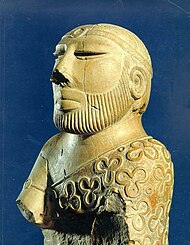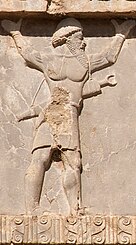Paropamisadae
| History ofAfghanistan |
|---|
 |
| Timeline |
| History ofPakistan |
|---|
 |
| Timeline |
ParopamisadaeorParapamisadae(Ancient Greek:Παροπαμισάδαι or Παροπανισάδαι) was asatrapyof theAlexandrian Empirein modernAfghanistanandPakistan,which largely coincided with theAchaemenidprovince ofParupraesanna.It consisted of the districts ofSattagydia(Bannubasin),Gandhara(Kabul,Peshawar,andTaxila), andOddiyana(Swat Valley).[1]Paruparaesanna is mentioned in theAkkadian languageandElamite languageversions of theBehistun InscriptionofDarius the Great,whereas in theOld Persianversion it is calledGandāra.[2][3]The entire satrapy was subsequently ceded bySeleucus I NicatortoChandragupta Mauryafollowing a treaty.[4]
Name[edit]
Paropamisadaeis theLatinizedform of theGreeknameParopamisádai(Παροπαμισάδαι),[5]which is in turn derived fromOld PersianPara-uparisaina,meaning "Beyond the Hindu Kush", where theHindu Kushis referred to asUparisaina( "higher than the eagle" ).[6]
In theGreek languageandLatin,"Paropamisus"[7][8](Παροπαμισός,Paropamisós)[9]came to mean theHindu Kush.[5] In many Greek and Latin sources, particularly editions ofPtolemy'sGeography[10]where their realm is included on the 9th Map of Asia,[11]the names of the people and region are given asParopanisadaeandParopanisus.They also appeared less frequently asParapamisadaeandParapamīsus(Παραπάμισος,Parapámisos),[12]Paropamīsii,etc.[5]


The name was also applied to a nearby river, probably the Obi river.[5]The mountain rangeSelseleh-ye Safīd Kūhis also calledParopamisusorParopamisus Mountains.
Geography and peoples[edit]


Strabodescribes the region as follows:
The geographical position of the tribes is as follows: along the Indus are the Paropamisadae, above whom lies the Paropamisus mountain; then, towards the south, theArachoti;then next, towards the south, theGedroseni,with the other tribes that occupy the seaboard; and the Indus lies, latitudinally, alongside these places; and of these places, in part, some that lie along the Indus are held by Indians, although they formerly belonged to the Persians. Alexander took these away from the Arians and established settlements of his own, butSeleucus I Nicatorgave them toSandrocottus,upon terms of intermarriage and of receiving in exchange 500 elephants.
Alongside the Paropamisadae, on the west, are situated theArii,and alongside the Arachoti and Gedrosii theDrangae;but the Arii are situated alongside the Drangae on the north as well as on the west, almost surrounding a small part of their country.[4]
Thus the region was north ofArachosia,stretching up to theHindu KushandPamir mountains,and bounded in the east by theIndus River.It mainly included theKabul region,Gandharaand the northern regions such asSwatandChitral.[13]
The nations who composed the Paropamisadae are recorded as theCabolitae(Καβολῖται) in the north near modernKabul;the Parsii (Πάρσιοι) in the northwest, the Ambautae (Ἀμβαῦται) in the east and the Par(g)yetae (Παρ(γ)υῆται) in the south, who were also found in Arachosia. The major cities of the land were the city of Ortospana (Ὀρτοσπάνα) or Carura (Κάρουρα), probably identifiable with Kabul,[14]Gauzaca (Γαύζακα), probably modernGhazni,Capissa (Καπίσσα), modern-dayKapisa,and Parsia (Παρσία), the capital of the Parsii.[citation needed]
History[edit]
In the ancientBuddhisttexts, theMahajanapadakingdom ofKambojacompassed the territories of Paropamisus and extended to the southwest ofKashmiras far asRajauri.The region came underAchaemenid Persiancontrol in the late 6th century BC, either during the reign ofCyrus the GreatorDarius I.[15]

In the 320s BC,Alexander the Greatconquered the entireAchaemenid Empire,beginning theHellenistic period.TheGreekname Παροπαμισάδαι or Παροπαμισσός was used extensively inGreek literatureto describe the conquests of Alexander and those of the kings of theGreco-Bactrian Kingdomand theIndo-Greek Kingdom,from the 3rd to the 1st centuries BC.
After Alexander's death in 323 BC, the area came under control of theSeleucid Empire,which gave the region to theMauryan Dynastyof India in 305 BC.[16]After the fall of the Mauryans in 185 BC, theGreco-Bactriansunder KingDemetrius Iannexed the northwestern regions of the former Mauryan Empire, including Paropamisus, and it became part of his EuthydemidIndo-Greek Kingdom.The Eucratidians seized the area soon after the death ofMenander I,but lost it to theYuezhiaround 125 BC.
See also[edit]
References[edit]
Citations[edit]
- ^Eggermont, Alexander's Campaigns in Sind and Baluchistan 1975,p. 175.
- ^Eggermont, Alexander's Campaigns in Sind and Baluchistan (1975,p. 176, 177): "One should, therefore, be careful to distinguish the limited geographical unit of Gandhāra from the political one bearing the same name."
- ^Perfrancesco Callieri,INDIA ii. Historical Geography,Encyclopaedia Iranica, 15 December 2004.
- ^abEggermont, Alexander's Campaigns in Sind and Baluchistan 1975,pp. 175–176.
- ^abcdShort, Charles; et al. (1879),"Paropamisus or Paropanisus",A Latin Dictionary,Oxford: Clarendon Press.
- ^Eggermont, Alexander's Campaigns in Sind and Baluchistan 1975,p. 176.
- ^Mela,De Situ Orbis,Bk. I, Ch. 15, §2.
- ^Plin.,Nat. Hist.,Bk. VI, Ch. 17, §20.
- ^Strabo,Geog.,Bk. XV, p. 689.
- ^Ptol.,Geog.,Bk. VI, Ch. 11, §17.
- ^Versions of Ptolemy's 9th regional map of AsiaatWikicommons.
- ^Arrian,Anab.,Bk. V, Ch. 4, §5.
- ^Eggermont, Alexander's Campaigns in Sind and Baluchistan 1975,pp. 175–183.
- ^Sir William Smith, A Dictionary of Greek and Roman Geography:Iabadius-Zymethus(J. Murray, 1873) p 553.
- ^Zournatzi, Antigoni (2003). "The Apadana Coin Hoards, Darius I, and the West".American Journal of Numismatics.15:1–28.JSTOR43580364.
- ^Romila Thapar (1963).Asoka and the Decline of the Mauryas.Internet Archive. p. 16.
Certain areas in the north-west were acquired through the treaty with Seleucus... It has been suggested that the territory ceded consisted of Gedrosia, Arachosia, Aria, and the Paropamisadae.
Bibliography[edit]
- Eggermont, Pierre Herman Leonard (1975),Alexander's Campaigns in Sind and Baluchistan and the Siege of the Brahmin Town of Harmatelia,Peeters Publishers,ISBN978-90-6186-037-2
- The Greeks in Bactria and Indiaby W.W. Tarn, Cambridge University Press




